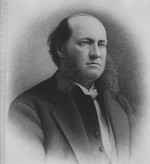|


|
|
|
Click to visit the
Official Town Site
|
|
|
|
|
|
History: Cornwall Presbyterian Church

|
| Cornwall Presbyterian Church |

|
| Rev. Louis P. Ledoux |
In 2006, members of the Cornwall Presbyterian church celebrate 150 years in their church located in the heart of the village. As part of the celebration, members reflected on the achievements of the women and men who founded the new congregation.
The church, built by Daniel Taft, served 17 original members, 12 women and 5 men, many of whom had withdrawn from the original Canterbury Presbyterian church in 1855. The small group first held services at the school room of Alfred C. Roe on Academy Avenue while they raised $1,000 to buy a plot of land and build their new home. Renown builder Daniel Taft built the new structure and it was inaugurated in May, 1856.
First Presbyterian Church, in Canterbury, Opened in 1827
Here's how the church describes its founding:
"Most of the founders of the Cornwall Presbyterian Church were members of the Canterbury Presbyterian Church which was organized in 1827. Canterbury, now Cornwall, was a struggling village centered around the general store (Chadeayne's, where there is now a traffic circle). It was a regular stagecoach stop on the Post Road that led through the Ramapo Valley from New York through Canterbury and Newburgh to Albany.
"Until 1855 there was no church between Canterbury and Cornwall Landing. Families living in the village of Cornwall either worshipped in Canterbury or did not go to church. The Puritanical customs of the church were strict and attendance at Sunday services was considered mandatory except for excuses such as sickness or death. An absent member without excuse would be visited by a committee from the church. He was expected to 'repent his sin' before the congregation. The Rev. James Silliman, pastor of the Canterbury Church in 1855, had the reputation of being a very strict disciplinarian.
Slavery Issue Played a Role in New Congregation
"Because of the slavery issue and the fact that several members of the congrgation preferred a less rigid form of religion, a motion was made by the Trustees in September 1854 to request the resignation of Mr. Silliman. But when the congregation met to act on the matter in April 1855, a vote was taken 43 to 8 choosing to retain their minister. These eight dissenters, along with other members, withdrew from the Canterbury Church and began to hold Sunday services in the schoolroom of Mr. Alfred C, Roe."* .
Pastor from the South Founds School
The church's first official pastor was a minister born in Louisiana who was invited to lead the newly formed congregation 1856. Louis Palemon Ledoux received degrees from Amherst College and the Union Theological Seminary before taking up the leadership of the village church. Under his guidance, church membership grew to 90. Ledoux also taught many of the children from the church at his home. When poor health forced his retirement as pastor in 1867, Ledoux founded the Boy's Institution, or Stone School, which later became Storm King School.
Trustees Inspired by the Social Gospel
The first trustees of the church were James O. Adams, David Caron, Henry N. Clark, Rev. Daniel Crane, Stephen Gillis, John McKibbon, James G. Roe, Peter Roe, and Thomas Wiley. Wiley and the Roe brothers went on to become the first elders of the church in 1865. Their younger brother, Edward R. Roe, later became active in the church and he also gained fame as a writer and wrote many books. According to current pastor Dan Russell, many of the church leaders were proponents of the social gospel, a movement that says the church should focus on caring for the poor.
Two Churches Re-unite, then Split
In 1924 members of the two Presbyterian churches, one in Canterbury and one in Cornwall-on-Hudson, voted to consolidate. Membership in the two churches had dropped off and members believed that by combining resources in one congregation they would strengthen Presbyterianism. Services would alternate between the two churches, while employing just one minister.
This arrangment proved untenable and in 1957, the two churches split apart again.
Pastor Russell Leads Church Today
Today, pastor Daniel J. Russell, Jr. finds meaning in the past for his congregation today.
"My mission today is to serve the poor," says Russell. "We are all poor in resources or in spirit or poor in our ability to get beyond what we are not comfortable with ý color, creed or social standings."
To held build bridges with those outside, the Cornwall Presbyterian Church is currently hosting an intern from South Korea, offering an opportunity for the doors of this historic church to swing wide open to the world. *From: "History of Cornwall Presbyterian Church 1856-1976," self-published brochure
Comments:
No comments have been posted.
Add a Comment:
Please signup or login to add a comment.
|
 |
|
|
|